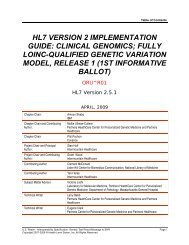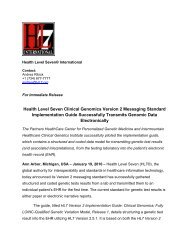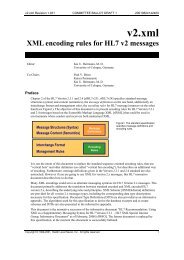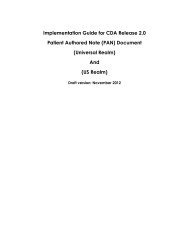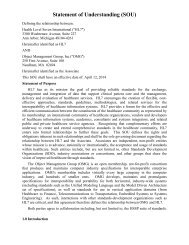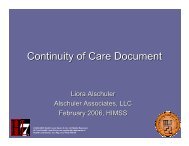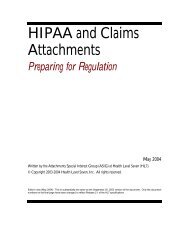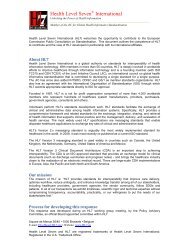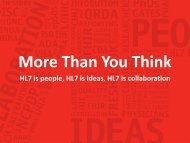HL7 CDA R2 AIS Implementation Guide
HL7 CDA R2 AIS Implementation Guide
HL7 CDA R2 AIS Implementation Guide
Create successful ePaper yourself
Turn your PDF publications into a flip-book with our unique Google optimized e-Paper software.
<strong>HL7</strong> Additional Information Specification <strong>Implementation</strong> <strong>Guide</strong><strong>CDA</strong><strong>R2</strong><strong>AIS</strong>0000R0303.6.1.1 One or more identifiers may be present, and identify the act being recorded. The identifier of theact has a required root attribute, which may be a GUID or OID. The extension attribute may bepresent, and is a string that may further identify the act within the namespace identified by theroot attribute.3.6.1.2 The element is required, and further refines the kind of act being recorded. This willoften be the LOINC answer part code. Each <strong>AIS</strong> shall indicate what code to place on an entry.The code attribute is required and contains the code value. The codeSystem attribute shall bepresent, and is the OID for the coding system used. Values for coding systems can be obtainedfrom the <strong>HL7</strong> OID registry accessible from the <strong>HL7</strong> home web page at http://www.hl7.org. ThecodeSystemName attribute may be present, and is a human readable name for the coding system.The displayName attribute may be present, and is a human readable description of the code value.Codes for procedures, medications, diagnoses, and observations can be obtained from a variety ofsources, including CMS (NDC, HCPCS, ICD-9-CM, and ICD-10-CM), the National Library ofMedicine (RxNORM), the Regenstrief Institute (LOINC), SNOMED (SNOMED CT) and theAmerican Medical Association (CPT-4). Additional vocabularies are also available from the<strong>HL7</strong> Version 3 Vocabulary tables, available to <strong>HL7</strong> members through the <strong>HL7</strong> web site.Additional Information Specifications may restrict the coding systems that are permitted for aparticular .3.6.1.3 The element may be present, and records the "biologically" effective time of theact, which is not necessarily the same as when it was recorded or determined. For example, adiagnosis of an illness occurs after the onset, but its effective time is from the onset to theresolution of the illness. Each Additional Information Specification shall indicate whether thiselement need be recorded.The element may be a time stamp, date range, or more complex timing structuredepending upon the use. For almost all acts, is represented either as a timestamp, or as a range. Only a act uses a more complex timingstructure.Page 48March 2007Copyright © 1998-2007Health Level Seven, Inc. All rights reserved.Release 3.0 Draft Standard




